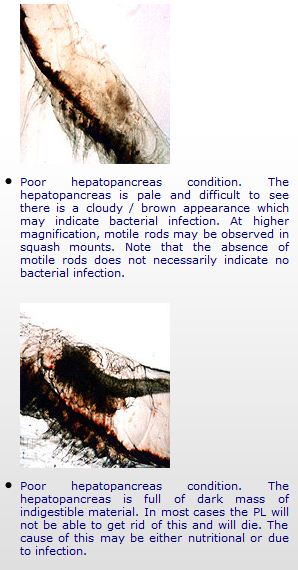Hepatopancreas Condition
The condition and appearance of the hepatopancreas gives a good indication of the feeding state and condition of the PL. In starved animals, the hepatopancreas takes on a shrunken, pale appearance whereas in well- fed animals, the full and dark or coloured hepatopancreas is due to the feed ingested. If the hepatopancreas is shrunken, it indicates that the PL are underfed or are not actively feeding, neither of which is desirable for PL to be stocked in grow-out ponds. Other features to look for in the hepatopancreas are the presence of large numbers of digestive vacuoles giving the hepatopancreas and the foregut a “bubble”-like or turbid appearance. This indicates that the shrimp are both feeding and digesting well. The movement of the gut (peristalsis) should also be strong. In some cases, the hepatopancreas may appear dark. However, on closer inspection, it can be seen that it is full indigestible material. Digestive vacuoles are few and/or peristalsis is weak or absent. If the hepatopancreas is empty but not excessively shrunken, this may simply indicate that PL need to be fed or that there is not enough feed in the tank. In this case, a second sample can be taken one or two hours after feeding to see if the condition improves. Similarly, if the hepatopancreas is full but there are no digestive vacuoles present, this may indicate that the PL has only recently been fed.





